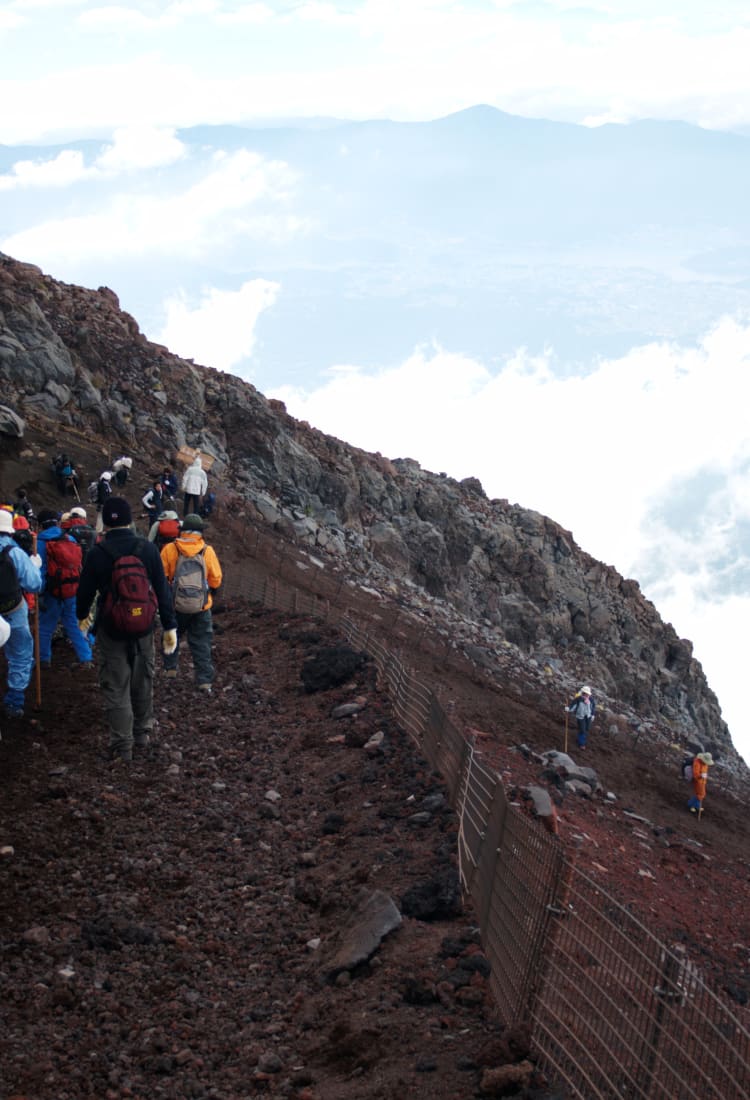Find out everything you need to know about the Yoshida trail before beginning your climb of Mt. Fuji
Easy access and plenty of facilities make the Yoshida trail the most popular route for climbing Fuji .
The ascent starts from the Fuji-Subaru Line 5th Station . Make your way up through the ascending stations, and if you purchase a walking stick get it stamped at the various mountain huts along the way. Enjoy the views from the trail.

The Yoshida trail at a glance
Start at Fuji-Subaru Line 5th Station—2,300 meters above sea level
Ascent: 6.8km trail. Approximately five to seven hours. Many facilities available
Descent: (Distance is under confirmation). Approximately three to five hours. No mountain huts/limited facilities from the 8th station down
Route overview
The Yoshida trail is by far the most popular of the four routes, with nearly triple the number of climbers as the Fujinomiya trail , the second most popular. From the 6th to 7th stations, it features a zigzagging path with a gentle slope. Past the 7th station it becomes even rockier, and from the 8th station, it merges with the Subashiri trail for both the ascent and descent. This area can become congested, especially during the pre-sunrise hours.
Facilities
The Yoshida trail is relatively the easiest route to ascend Mt. Fuji and also has the most facilities, located about every hour to ninety minutes apart. These include first-aid centers and doctors at the 5th, 7th and 8th stations, vending machines and mountain huts. At the 6th station guidance center, helmets can be borrowed for a 2,000 yen refundable deposit. At all the huts there are toilets available (for a small fee), and staff that can stamp walking sticks. When you make it to the top, you can even post a letter from the summit.

Starting your trek
The Yoshida trail actually begins at Kitaguchi Hongu Fuji Sengen-jinja at the base of Mt. Fuji. In years past, this shrine was the traditional starting point for climbing the mountain from its northern side. Nowadays, most people start from the Fuji-Subaru Line 5th Station, significantly shortening the total hiking time.



Accessing the trailhead
Access the main trailhead at Fuji-Subaru Line 5th station by express bus from Tokyo, by local bus from nearby train stations, or by car.
Express buses from Tokyo operate from Shinjuku during the climbing season. Reservations are necessary.
From Fujisan or Kawaguchiko stations to the 5th station, buses depart at least once an hour starting at 6:20 a.m. These buses don't require any reservation and cost 2,300 yen round trip.
If you're renting a car, drive to the Fujihokuroku parking area (1,000 yen per car) and take a shuttle to the fifth station (2,100 yen round trip). Shuttles depart every 30 minutes from 5:30 a.m. to 7:00 p.m., with an earlier shuttle available on Friday and Saturday.

The climb
From the 5th station to the summit, expect the ascent to take at least six hours. The longest stretch is from the 7th to the 8th stations, which can take over 100 minutes to complete, and goes from 2,700 meters to 3,100 meters in elevation. Around here the terrain also changes from a flat, zigzag pattern to a steeper, rocky hike. The most congested and slowest part can be from the eighth station to the summit, as the Yoshida and Subashiri trails converge. Leave yourself plenty of time if you're attempting to reach the summit for the sunrise.
As this is the easiest trail in comparison to the other Fuji trails, enjoy the ascent and descent as much as possible taking in the scenery. Set a comfortable pace from the beginning, and take frequent (hourly) breaks. Pay attention to the path markers, especially on the descent. Subashiri and Yoshida share one path to the 8th station and then fork, making it easy to accidentally head down the wrong trail if you're not paying attention. Follow the yellow path marker for the Yoshida trail.

Where to stay
For those interested in staying at a mountain hut before making a sunrise ascent, it is highly recommended to make a reservation before heading to the mountain. Goraikokan is located at the midway station between the 8th and 9th stations, roughly 3,450m above sea level. Sleeping facilities are basic, you're provided with a blanket and pillow and will sleep in a communal space with everyone else. Prices start at 11,000 yen.
Taishikan is located at the 8th station, 3,100m above sea level and about two and a half hours from the summit. They offer each person their own premium sleeping bag and designated space. Prices start at 10,000 yen for one night with two meals.
Kamaiwakan is found at the seventh station, 2,790m above sea level. This spot is only a couple of hours from the Yoshida 5th station. Prices start at 10,000 yen for a weekday space with a meal. Sleeping bags and pads are provided in a bunk-bed dormitory or a private or single room.
For additional information and alternative options, check the complete list of Fuji mountain huts .

The latest information may differ, so please check the official website






















































